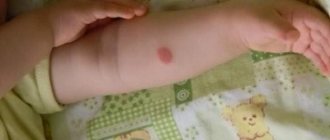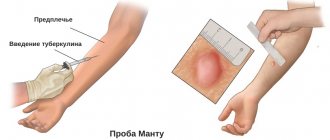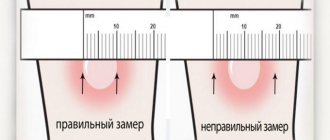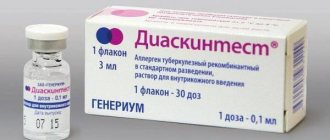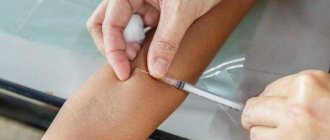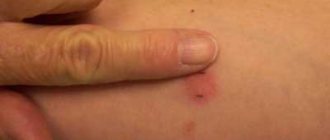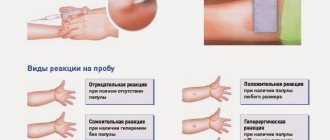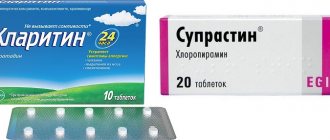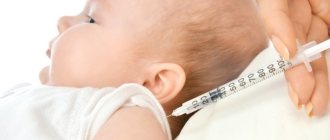The Mantoux test is used to measure the human body's immune response to tuberculin, a heat-treated, specially processed fragment of tuberculosis bacteria. Intradermal administration has been used for over 70 years worldwide. In adults, the test shows whether a person is infected with the tuberculosis bacillus or not. For children, the Mantoux test is used for a slightly different purpose.
The sample is injected into the top layer of skin by lifting the skin with a needle. Intradermal administration is used mainly for the forearm, for its middle part.
WHAT IS THE MANTOU REACTION
The Mantoux test is designed to provoke an immune response. It has nothing to do with vaccination, so it is incorrect to say that Mantoux is a vaccination. In order for the human body to respond to a microbiological invasion, the immune system must be familiar with these microorganisms. The immune system can only respond to threats with which it is already familiar. The immune system will not be able to recognize new infections until a person is vaccinated or has had a certain disease.
If the immune system is familiar with tuberculin bacteria, when they are introduced, immune cells will attack tuberculin. In this case, a local inflammatory reaction will be observed.
Contraindications
Since tuberculin used for Mantoux does not contain dangerous microorganisms and substances, its introduction into a child’s body at any age is completely harmless. Even children with somatic ailments do not suffer from any negative manifestations.
However, at the same time, there are certain contraindications for the introduction of the tuberculin vaccine. In particular, it is prohibited to perform Mantoux on a child with skin diseases or exacerbations of chronic pathologies.
Possible complications and deviations may also arise in the case of individual non-acceptance of tuberculin.
Important! Testing is prohibited for children if they have allergies. The vaccine will be difficult for the body to accept, and an allergic reaction will only worsen the condition.
You cannot do the Mantoux test with the introduction of other vaccines. Their active ingredients may conflict. For this reason, it is better to do the next vaccination after the Mantoux test, in particular when recording its results.
We recommend reading! Follow the link: Sign of the first symptoms of tuberculosis, causes of the disease
WHY DO THEY MAKE MANTU FOR CHILDREN?
There are several purposes for testing in childhood:
- Identification of uninfected patients for subsequent vaccination. Using a test, you can find out whether there is a response to tuberculin.
- Checking the dynamics of test results over several years. Using this information, one can determine the Mantoux “turn”, the presence of tuberculosis with a high degree of probability.
- Determination of a severe reaction that requires additional research.
In adult patients, the test is a reliable, sensitive test for determining the presence of the tuberculosis pathogen in the body.
Children begin testing at age 1 and finish testing at age 15. Mantoux is administered annually.
What does Mantoux look like for tuberculosis?
If a person is sick with tuberculosis, there are several ways to determine this using Mantoux. The first is the presence of a positive intense response or even a hyperergic reaction (the size of the papule exceeds 14 mm).
The second signal of concern is a positive reaction when a papule is more than 12 mm, which does not change for four years. Larger button sizes may occur after tuberculosis vaccination (BCG). Within 1-2 years, a positive result of moderate intensity can be observed. However, it should decrease every year. If this does not happen, the child is referred to a TB specialist for research.
Another, most significant, indicator of infection of the body with tuberculosis is the presence of tuberculin variation. This medical term characterizes a sharp increase in Mantoux papules (by 6 or more millimeters) in comparison with the results of studies in previous years. It is most clearly expressed when a negative Mantoux reaction changes to a positive one in the absence of the fact that an anti-tuberculosis vaccination with the BCG vaccine was performed between two samples.
A large papule in a child: is there any cause for concern?
A positive intense or hyperergic (sharply positive) papule is considered a dangerous signal. At the same time, a positive result can be caused by other circumstances. To clarify, the child is sent to a TB specialist. The doctor must first determine the following data:
- timing of BCG;
- the presence of infectious diseases, when they were diagnosed and how they progressed;
- the possibility of an allergic reaction to any component of the drug.
It is often possible to determine the degree of danger of a large Mantoux in a child visually. It is characterized by a uniform pink color. In case of tuberculosis, the button acquires a dark shade.
A hyperergic reaction is diagnosed in cases where the diameter of the button exceeds 16 mm. After this, a visit to a phthisiatrician and the appointment of additional examinations are inevitable. Hyperergic symptoms may be accompanied by signs of inflammation: enlarged lymph nodes, the appearance of ulcers, etc.
COMPOSITION OF THE PREPARATION
To perform testing, tuberculin tests are used, consisting of:
- Chemically, thermally treated fragments of bacteria.
- Twin-80 – stabilizer.
- Phenol is a preservative.
- Potassium and sodium phosphates.
- Sodium chloride.
- Water.
As a rule, many parents are frightened by the presence of phenol in the composition of the drug. Yes, it is a toxin, but its presence in the sample is minimal. Therefore, there is no harm to health. Low concentrations of the substance in medical preparations are justified for use.
Why doesn't the manta trail go through?
There can be a lot of factors why the trace of a manta ray does not go away for a long time. The most common of them is the individual characteristics of the body. For some people, the test will pass 4-5 days after the administration of the drug, at the same time, there is a category of people for whom the effect remains for the rest of their lives. If the child feels well, but the manta does not pass, it is too early to ring the bells.
In addition, the healing of the mark is greatly influenced by how long ago the child was vaccinated with BCG. After all, it is aimed at creating immunity against the bacillus, the extract from which is administered during the Mantoux test. If BCG was done very recently, the mark may acquire a bright red tint and may not go away for a long time.
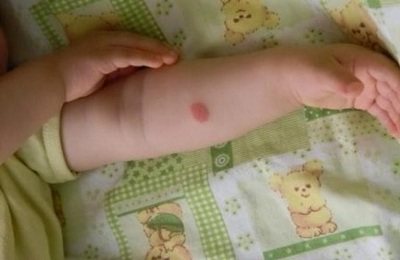
Also, healing is directly affected by the saturation of the blood with protein enzymes. Children whose spots do not heal for too long may be referred to a specialist for further examination to accurately rule out the risk of disease. It is worth noting that if the child is allergic, then the possibility of an allergy to the administered drug cannot be ruled out. An allergy to an extract from a tuberculin bacillus gives a quick and false-positive result, in which case you need to consult a doctor and stop the effects with antihistamines, then the trace will go away.
The reasons for the long healing of Mantoux may be purely mechanical. For example, the mark cannot be rubbed, steamed or treated with brilliant green and hydrogen peroxide. Some doctors do not even recommend covering it with a band-aid. Under no circumstances should you squeeze the swollen area!
NORMAL FOR CHILDREN
After the first BCG vaccination, children retain anti-tuberculosis immunity for up to 7 years. How well it is preserved depends on the diameter of the scar after the test. It remains on the left shoulder. If there is no such round mark, this means that the BCG vaccination was not given, and the child does not have immune protection against tuberculosis.
Table 1. Preservation of anti-tuberculosis immunity after BCG vaccination depending on the diameter of the post-vaccination scar.
| Diameter post-vaccination rib, mm. | Duration of anti-tuberculosis immunity, years |
| up to 2 | until 3 |
| up to 4 | up to 4 |
| until 6 | up to 5 |
| 8 or more | up to 7 |
The age of the patient decides what the reaction to the test should be:
- 1 year. The papule is 5-10 mm in size, regardless of the size of the post-vaccination scar.
- 2-6 years. The intensity of anti-tuberculosis immunity reaches its maximum by the age of 2 years. If the scar is larger than 8 mm, the papule can reach 16 mm. After 3 years, the immune response dies down. However, at 4-5 years old, children still have a positive or questionable reaction, and the size of the papule at the age of 4-6 years is considered normal if it does not exceed 10 mm.
- 6-7 years. At this age, patients have a negative or questionable response to the test. A negative result is a signal about the need for re-vaccination. Routine revaccination is performed at 7 years of age.
7-14 years old. As after the first vaccination, the intensity of immunity remains in the first 3 years, and then begins to subside. Therefore, the response to injected tuberculin fades by the age of 10 years. By the age of 13-14, patients have a negative, questionable response to the test.
Table 2. Correlation between the normal size of the papule and the size of the post-vaccination scar in children aged 3-5 years.
| Diameter of post-vaccination scar, mm. | Papules norm, mm |
| up to 2 | no reaction |
| up to 4-6 | 5-6 |
| 6 or more | to 10 |
Adverse reactions
The reaction after Mantoux in children may manifest itself as the following symptoms:
- Fever and chills. Worsening of health is observed in the evening after the injection or the next morning. The temperature rises slightly (up to 37.5-38°C). Sometimes nausea and dizziness occur. As the temperature normalizes, the child's condition improves.
- Skin rashes and itching. Redness can appear on any part of the body. Some children experience swelling of the face and mucous membranes of the nasopharynx. The phenol contained in the injection sometimes causes allergies. If the patient is intolerant to some components of the sample, alternative drugs are prescribed. To treat the rash, you can use Dimexin ointment.
- Decreased appetite, pain in the abdominal area. Severe diarrhea may occur. In this case, the child should be given more fluid.
- Lethargy and drowsiness.
- Strong headache. Often this symptom is accompanied by a cough, runny nose and other signs of colds. It is recommended to give tea with honey to drink at night.
- Nausea and vomiting.
- Blue papule. When the injection was administered, the blood vessels were damaged.
If your health does not improve within 3 days, it is recommended to seek medical help.
REACTION TO TEST BY DAY
A reaction to Mantoux is observed in patients on the second day after the test. The body may react with the formation of a papule and/or redness. The maximum immune response can most often be noted on the third day. The reaction can be negative, false negative or positive, false positive:
- Negative. The absence of any reaction indicates that the immune system is not familiar with tuberculosis pathogens. The patient does not suffer from tuberculosis in any form. If a child has had less than 5 years since vaccination, a negative reaction is a bad signal. He reports that the immune system does not remember danger. If more than 5 years have passed, then the lack of reaction is a plus. This is a sign that the child is not sick. The same rule works for adults.
- False negative. This reaction can be observed in cases where a person’s immune system stops responding to injected tuberculin over the years.
- Positive. We can talk about such a reaction to the test if the papule is larger than 5 mm in diameter. It is necessary to analyze a positive result in children based on a combination of factors. It is necessary to evaluate the dynamics of the sample over the past years, the very nature of the papule, the size of the scar, and how long ago the vaccination was performed. If the reaction is positive in an adult, this is a signal of almost 100% probability of infection.
- False positive. This category includes questionable answers - redness of any size, papules with a diameter of less than 4 mm. A false positive reaction can occur in a number of cases. For example, when a person has recently undergone any vaccination or has had an infectious disease. Also, a questionable reaction occurs with a skin allergic reaction, etc. To make sure that there is no need to panic in case of a false positive result, it is necessary to check whether the patient has contacts with tuberculosis patients, the situation in the region, and whether the incidence threshold has been exceeded.
Mantoux vaccination: normal size for a child, vaccination schedule, care rules
Wednesday, April 20, 2016
The main method of preventing tuberculosis, which is carried out from the first days of a little person’s life, is the Mantoux vaccination, which is done annually. This is a kind of test that determines the presence of tuberculosis infection in the lungs. Tuberculin is injected under the skin on the inside of the wrist, and then the doctor observes the body's reaction to it.
This is a drug artificially created from tuberculosis microbacteria. If a child experiences severe redness or swelling at the injection site after Mantoux, his body is already familiar with harmful bacteria. In this case, an additional examination is prescribed and the diagnosis is clarified. Parents should know basic information about why, how and when children are vaccinated with Mantoux in order to prevent their child from contracting tuberculosis.
Vaccination schedule
There is a general Mantoux vaccination schedule for children, which parents are usually informed about in advance. However, in some cases, additional tuberculin may be prescribed - more often than other children.
1. The very first Mantoux vaccination for a child, which is given to the baby upon birth, is given in the maternity hospital on days 3–7 of the little person’s life. Vaccination helps the body develop immunity against tuberculosis.
2. After this, as the Mantoux vaccination calendar for children says, tuberculin is administered annually for constant monitoring of Koch’s bacillus, which can become active at any time.
3. If the child’s tuberculin test increases every time or there are infected patients in the child’s environment, Mantoux vaccination is done more often - up to 2-3 times a year, depending on the results of tests and additional examinations.
Only a doctor (phthisiatrician) can determine how many times to vaccinate a child with Mantoux. This will depend on the body’s reaction to tuberculin, since there are certain standards that the doctor is guided by. They can be not only general, but also individual.
Dimensions
Not knowing what rate of Mantoux vaccination a child should have, parents are often perplexed: for some, the swelling is quite large, but they are not sent for a repeat test, and for others, it is smaller, but they are referred to a TB specialist. There are some nuances here that can reassure particularly worried parents.
1. The Mantoux test in a child is considered negative (i.e., there are no problems) if no lumps or redness are detected at the injection site.
2. A questionable reaction is observed with slight hyperemia (redness) and the presence of a papule (the so-called swelling that rises above the skin up to 5 mm). In this case, they take previous samples from previous years (they look at the dynamics), identify the presence of infected patients in the baby’s environment, and can send them for consultation to a phthisiatrician.
3. A positive test is the presence of a papule whose height exceeds 5 mm. Then a consultation with a specialist is required and in most cases a repeat test is performed.
4. A pronounced problem is the presence of a papule larger than 15 mm, the formation of a crust or vesicle at the injection site.
The peculiarity of this vaccine is that the size of the Mantoux vaccination in children looks at the dynamics of previous years, since the reaction in this case is very individual. If a child’s papule is always large in size, he may not be sent for repeated tests. But if the difference between the size of the swelling of two consecutive vaccinations is significant, this will certainly arouse suspicion among doctors, and the child will be sent for additional examinations. However, it is worth considering here that sometimes the cause of increased Mantoux in children is not infection with tuberculosis.
Three whole days pass between the injection of tuberculin under the child’s skin and the measurement of the reaction, and during this time certain rules must be followed. Without them, an increase in Mantoux can be provoked by various external and internal factors.
- Allergy : if present, any contact of the child with the allergen must be excluded. If it is unknown at the time of Mantoux vaccination, parents should protect the baby during these three days from treatment with any medications, consumption of sweets and red foods, as well as from contact with animals.
- Low-quality vaccine : Mantoux is given free of charge, so low-quality tuberculin can be delivered to any medical and child care facility, which will give a positive result in any situation. The error can be identified by contacting another institution (preferably a paid one) for re-vaccination after 3 days after the Mantoux measurement, which did not satisfy the parents. This will help you draw the right conclusions and not make a mistake with the diagnosis.
- Incorrect measurement : usually the Mantoux vaccination is done by a qualified doctor, but during measurements the human factor can play a cruel joke. The specialist checking the reaction could be inexperienced, could simply not take into account some individual characteristics of a small organism, could use the wrong ruler, and could, in the end, simply make a mistake due to fatigue.
- Individual characteristics : a positive Mantoux reaction can be observed due to a hereditary factor or the abundance of large amounts of protein foods in the child’s diet. So during three test days you need to reduce your baby’s consumption of eggs, meat, and dairy products.
To reduce all these factors to a minimum, there are certain rules for caring for the injection site after Mantoux vaccination. This allows you to make measurements on the third day more accurate and trouble-free. Unfortunately, doctors do not always give such information to parents, and the latter, in turn, are of little interest in this.
Rules of care
Useful tips in this case help to act competently during the 3 days allotted to the small organism for the Mantoux reaction.
1. These days it is not recommended to take a shower, bath or go to the sauna. However, depriving children of water procedures is also fundamentally wrong, since dirt that gets into the puncture site can provoke an even more dangerous infection.
2. Do not allow the child to rub the vaccination site, as this contributes to the appearance of compaction and redness.
3. Avoid contact with allergens: pets, citrus fruits, vegetables, red fruits and berries, synthetics and other dangerous items.
4. If redness and thickening still occur, give some antihistamines.
5. If your hand was wet in a body of water, report the incident to the doctor, who will do a Mantoux reaction reading.
6. Do not stick various plasters on the vaccination site, do not bandage your hand, do not smear it with any disinfectant solutions or ointments.
Since the incidence of tuberculosis is high, and the infection itself is quite serious, parents are advised not to give up the Mantoux test for children, which helps control the spread of the disease. At the same time, you need to understand that the tuberculosis vaccine does not protect the child from infection 100%. Infection may occur upon contact with a sick person. However, a vaccinated baby will get a milder form of the disease, which makes death unlikely.
SIDE EFFECTS, COMPLICATIONS
An excessive response of the patient’s body to the administered drug is the cause of the main side effects. These include:
- Allergy. This reaction is possible in patients of any age, since tuberculin is an allergen.
- Temperature. With high sensitivity to the drug, a slight increase in temperature may be observed.
- Hyperergic reaction. Formation of papules larger than 17 mm in diameter. This answer indicates the presence of tuberculosis infection in the body.
- Cough. Traditionally, this side effect is not associated with the administration of the sample.
- The papule itches. It is necessary to avoid scratching the papule; the tuberculin injection site itself may itch.
Is it necessary to do a test at 2 years old?
The Mantoux test involves the injection of a tuberculin substance, which contains treated bacteria, under the skin. When they enter the body, they cause a response of the defense forces. Purpose of the sample:
- identify patients who have a reaction to the administered drug for further research to determine those who are infected with Koch's bacillus;
- track the child’s reaction to the drug for several years in a row, so tuberculin is administered both in the first year of life and in subsequent years;
- identify those who are not immune to this disease.
Despite the risk of symptoms of intoxication after tuberculin administration, Mantoux vaccination is considered safe at any age. The main thing is to take into account the child’s condition and the presence of contraindications.
If you do not take them into account, this will either lead to changes in the test results or to complications of current diseases.
According to pediatrician Komarovsky, it is necessary to do Mantoux at two years, with the exception of the following cases:
- skin diseases - in this case, papules may become larger, redness may spread over a large area, which will make it impossible to measure the reaction to Mantoux;
- infectious pathologies in acute form - the child’s body will be too exhausted, which is why a negative reaction to the injection may develop, which will distort the results of the analysis;
- during the period of exacerbation of chronic diseases, with epilepsy, joint pathology - in the latter case, the administered tuberculin can cause an exacerbation of the disease;
- after recent vaccinations;
- within 2-3 weeks after the blood transfusion procedure.
The test can be done only 1-1.5 months after the symptoms of the disease disappear, when the child’s body has recovered. Parents should not be given permission to take Mantoux if quarantine is introduced in the kindergarten - after the injection the child’s body becomes more susceptible to infections, which increases the risk of infection.
ALTERNATIVE TO MANTOU SAMPLE
For those who want to avoid the Mantoux test, there is an alternative option. The Diaskintest test has proven itself because it is less likely to produce false positive results. However, it produces false negative reactions more often. As a rule, Mantu is used as a basic test, and Diaskin as a clarifying test.
The Mantoux test is used to test the body's response to tuberculosis bacteria - whether the immune system can fight them. This test can give a false positive result in 80% of cases. But the diagnosis is confirmed in no more than 1% of cases in children. For adults, Mantoux is the main, most accurate and sensitive method for detecting tuberculosis infection.
How is the Mantoux reaction checked at 1 year of age, what does it look like?
The Mantoux reaction at 1 year of age is checked using a standard method - using a transparent ruler, the doctor immediately evaluates what the papule looks like. If it is not clearly red, loose, and there are no signs of ulceration or abscess formation, then this is considered normal.
How to measure yourself
You can measure the Mantoux papule yourself using a ruler or tape measure. It is applied perpendicular to the forearm. Things to remember:
- if there is no papule, then only the area of redness is measured;
- If there is a seal, the area around it is not taken into account when measuring.

When measuring redness without compaction and a characteristic “button”, it is worth using a ballpoint pen - it is used to outline the visually defined boundaries of the changed skin in order to obtain accurate results (when pressure is applied to the pen with a ruler, the area will automatically expand).
How long does it take to check?
The Mantoux test is checked strictly 72 hours after the intradermal administration of tuberculin; earlier measurements may give a false positive result, and later measurements may give a false negative result.
What can distort the result
A variety of factors can distort the result:
- increased sensitivity of the child's skin;
- history of allergies;
- problems with balancing the baby’s diet;
- living in regions with unfavorable environmental conditions;
- improper administration of tuberculin, violation of the rules for its storage and transportation.
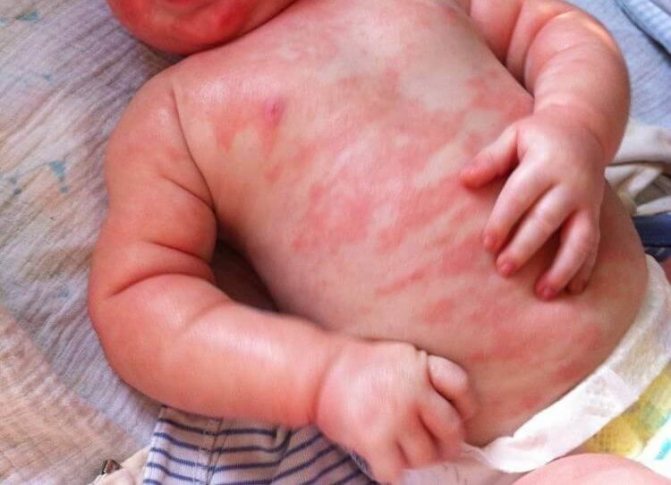
Allergic rash
What to do in case of deviations
If, when measuring Mantoux, the doctor finds any deviations from the norm, then the child will be referred for additional examination to a phthisiatrician - a specialist who diagnoses and treats tuberculosis specifically. What they can do:
- prescribe other types of tests to detect tuberculosis;
- perform X-ray diagnostics of the lungs, but this method is used extremely rarely for children, as there is a restriction - it is not possible for children under 14 years of age;
- refer the small patient's immediate environment for examination.
Beforehand, parents will be interviewed about proper care of the injection site.
Mantoux papule: what is it and what size is considered normal
Mantu is made for children from one to 14 years old. This is not a vaccination in the full sense of the word, but a method of screening for a disease.
Based on the results of the procedure, doctors judge the possible presence of pathogens of a serious illness in the body. Newborns are vaccinated against tuberculosis with BCG while still in the maternity hospital.
By the age of 7 years, the effect of the drug ceases. The test helps to find out whether the body still has immunity against infection.
Mantoux is made for the following purposes:
- Identification of those children whose reaction is strongly expressed. Additional examination is required, as there is a suspicion that they are sick.
- Monitoring dynamics over several years. It is used to judge that there may be pathogenic bacteria in the body and the development of tuberculosis has begun.
- Identification of persons who do not have an immune response to Mantoux (there is no lump or redness, only a trace of the injection remains in the form of a dot); such children must be vaccinated against the disease again.
You can find out information about tuberculosis prevention in the video from the Profilaktika Tomsk channel.
A special substance, tuberculin, is injected into the skin below the elbow on the inside of the arm with a syringe. It is impossible to get this disease from it. After all, the drug is made from particles of pathogenic mycobacteria that are neutralized by heating. This vaccine is considered non-live. No preparation is required on the part of the patient for the procedure.
